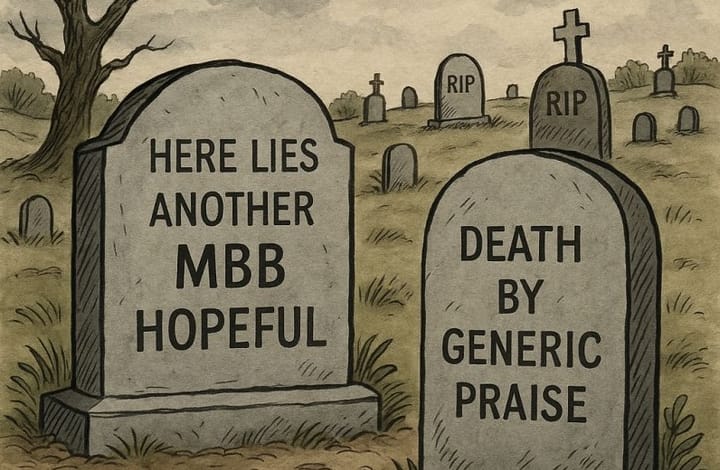What Won’t Work in the 2025-26 MBA Cycle (and What Will)

If you’re applying this season, you'll need to balance your ambitions with the realities of the job market. Recruiting is tight, and MBA admissions committees expect clear career goals and strong execution on your application materials.
Here’s what won’t work in the 2025–26 cycle... and a quick word on the one thing that absolutely will.
1) Esoteric and noncommittal career goals
Exploratory career goals and lofty pivots with no connection to your current career and skill set won't cut it. Employers are hiring later in the cycle, with more just-in-time processes. So, they need candidates who can hit the ground running – not spend two years finding themselves.
MBA admissions committees want candidates to share believable goals and a practical path from your professional experience → MBA → first role. As a result, “strategy at a mission-driven company” just won’t cut it... but “go-to-market strategy in B2B SaaS, building on X and Y experiences, recruiting across A / B / C firms with an internship in Z” signals your readiness.
Recent career data backs this up: even at elite programs, the job search process has been tough. So, clarity with in your career goals isn’t just a nice-to-have... it helps you manage your risk.
2) The MBB / FAANG-or-bust mindset
Yes, some classmates will land McKinsey / Bain / BCG or the biggest tech companies... but most won’t, and most don’t need to. Our research on 4,000+ Class of 2024 MBAs shows that the long tail is the market: thousands of companies across functions and industries hire just 1-2 MBAs each. If your search is only focused on a handful of recognizable names, you’re missing most of the market.
In consulting, that means looking beyond MBB to tier 2, strategy boutiques, ops and turnaround companies, and specialist firms. In tech, it’s pursuing product, growth, analytics, and partnerships roles at companies of all sizes in specific verticals. Our industry analyses reinforce the same point: consulting ≠ MBB and tech ≠ FAANG; each is a collection of micro-markets with their own timelines and processes. Explore them with intention!
Why this matters now
As discussed, internship and full-time recruiting has been competitive across top MBA programs. Even schools with deep employer networks describe a “highly competitive job market” and more just-in-time hiring. That reality rewards candidates who are focused, determined, and aware of what the market will allow.
What will work: demonstrate your self-awareness
If you only double-down on one factor, consider this: strong self-awareness – knowing your strengths, weaknesses, and why the MBA is the best next step – helps you develop stronger goals, better essays, and a tighter recruiting plan. We break down how to build and demonstrate it here.
TL / DR: share evidence, be specific, and align your story with the job market.
A quick note on application volume and the competitiveness of the cycle
There’s a prevailing belief that application volume could soften this year. Overall, it might. However, that doesn't mean the admissions process will be less competitive. Top MBA programs aren’t likely to lower their standards, so expect stats (tests scores, GPAs, etc) to trend upward from last year (as they do most years).
How to put this into practice
If you're developing your MBA applications now, here's what to do next:
- Commit to a target role first. Pick the problem you want to solve and build a firm list that fits that – not the other way around. Understand the long-tail market data and industry analyses to widen your lens on the market.
- Stress test your goal. Identify the skills you already have, the gaps you’ll close during the MBA, and the exact classes / clubs / internships / programs, etc. that will make your transition possible.
- Show your self-awareness. Back up your goals with evidence and ensure that your choices (your school list, recommenders, resume bullets, etc.) reflect a focused plan.
If you do these three things, you'll be in good shape to put your best foot forward in the admissions process. Good luck!
Subscribe to our newsletter to get insights delivered straight to your inbox.



